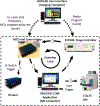The development and application of matrix assisted laser desorption electrospray ionization: The teenage years
- PMID: 34028071
- PMCID: PMC11609267
- DOI: 10.1002/mas.21696
The development and application of matrix assisted laser desorption electrospray ionization: The teenage years
Abstract
In the past 15 years, ambient ionization techniques have witnessed a significant incursion into the field of mass spectrometry imaging, demonstrating their ability to provide complementary information to matrix-assisted laser desorption ionization. Matrix-assisted laser desorption electrospray ionization is one such technique that has evolved since its first demonstrations with ultraviolet lasers coupled to Fourier transform-ion cyclotron resonance mass spectrometers to extensive use with infrared lasers coupled to orbitrap-based mass spectrometers. Concurrently, there have been transformative developments of this imaging platform due to the high level of control the principal group has retained over the laser technology, data acquisition software (RastirX), instrument communication, and image processing software (MSiReader). This review will discuss the developments of MALDESI since its first laboratory demonstration in 2005 to the most recent advances in 2021.
Keywords: FTMS; IR lasers; MALDESI; MSiReader; ambient ionization; direct analysis; mass spectrometry imaging.
© 2021 John Wiley & Sons Ltd.
Figures




















Similar articles
-
Next-Generation Infrared Matrix-Assisted Laser Desorption Electrospray Ionization Source for Mass Spectrometry Imaging and High-Throughput Screening.J Am Soc Mass Spectrom. 2022 Nov 2;33(11):2070-2077. doi: 10.1021/jasms.2c00178. Epub 2022 Sep 29. J Am Soc Mass Spectrom. 2022. PMID: 36173393 Free PMC article.
-
Application of infrared matrix-assisted laser desorption electrospray ionization mass spectrometry for morphine imaging in brain tissue.Anal Bioanal Chem. 2023 Sep;415(23):5809-5817. doi: 10.1007/s00216-023-04861-x. Epub 2023 Jul 25. Anal Bioanal Chem. 2023. PMID: 37490153 Free PMC article.
-
Normalization techniques for high-throughput screening by infrared matrix-assisted laser desorption electrospray ionization mass spectrometry.J Mass Spectrom. 2022 Jun;57(6):e4869. doi: 10.1002/jms.4869. J Mass Spectrom. 2022. PMID: 35678360 Free PMC article.
-
Surface analysis of lipids by mass spectrometry: more than just imaging.Prog Lipid Res. 2013 Oct;52(4):329-53. doi: 10.1016/j.plipres.2013.04.005. Epub 2013 Apr 24. Prog Lipid Res. 2013. PMID: 23623802 Review.
-
Desorption electrospray ionization and matrix-assisted laser desorption/ionization as imaging approaches for biological samples analysis.Anal Bioanal Chem. 2023 Jul;415(18):4125-4145. doi: 10.1007/s00216-023-04783-8. Epub 2023 Jun 17. Anal Bioanal Chem. 2023. PMID: 37329466 Review.
Cited by
-
SMART: A data reporting standard for mass spectrometry imaging.J Mass Spectrom. 2023 Feb;58(2):e4904. doi: 10.1002/jms.4904. J Mass Spectrom. 2023. PMID: 36740651 Free PMC article.
-
Review of Recent Advances in Lipid Analysis of Biological Samples via Ambient Ionization Mass Spectrometry.Metabolites. 2021 Nov 15;11(11):781. doi: 10.3390/metabo11110781. Metabolites. 2021. PMID: 34822439 Free PMC article. Review.
-
Maximized Spatial Information and Minimized Acquisition Time of Top-Hat IR-MALDESI-MSI of Zebrafish Using Nested Regions of Interest (nROIs).J Am Soc Mass Spectrom. 2023 Sep 6;34(9):2043-2050. doi: 10.1021/jasms.3c00210. Epub 2023 Aug 1. J Am Soc Mass Spectrom. 2023. PMID: 37526449 Free PMC article.
-
Single-cell and spatial omics: exploring hypothalamic heterogeneity.Neural Regen Res. 2025 Jun 1;20(6):1525-1540. doi: 10.4103/NRR.NRR-D-24-00231. Epub 2024 Jul 10. Neural Regen Res. 2025. PMID: 38993130 Free PMC article.
-
Quasi-continuous infrared matrix-assisted laser desorption electrospray ionization source coupled to a quadrupole time-of-flight mass spectrometer for direct analysis from well plates.J Mass Spectrom. 2023 Jan;58(1):e4902. doi: 10.1002/jms.4902. J Mass Spectrom. 2023. PMID: 36694312 Free PMC article.
References
-
- Ai W, Nie H, Song S, Liu X, Bai Y, & Liu H. 2018. A versatile integrated ambient ionization source platform. J Am Soc Mass Spectrom 29:7:1408–1415. - PubMed
-
- Andrade FJ, Shelley JT, Wetzel WC, Webb MR, Gamez G, Ray SJ, & Hieftje GM. 2008. Atmospheric pressure chemical ionization source. 2. Desorption−Ionization for the direct analysis of solid compounds. Anal Chem 80:8:2654–2663. - PubMed
-
- Andrade FJ, Wetzel WC, Chan GC-, Webb MR, Gamez G, Ray SJ, & Hieftje GM. 2006. A new, versatile, direct-current helium atmospheric-pressure glow discharge. J Anal at Spectrom 21:11:1175–1184.
Publication types
MeSH terms
Grants and funding
LinkOut - more resources
Full Text Sources
Other Literature Sources
Miscellaneous

